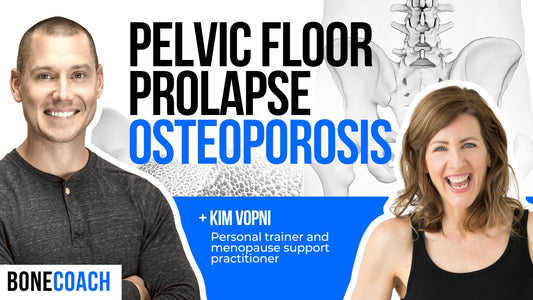In this episode of the Bone Coach Podcast, we're talking about PEMF therapy and osteoporosis. In my interview with Dr. William Pawluk, the foremost authority on Pulsed Electromagnetic Field (PEMF) therapy in North America, we discuss:
-
What are Pulsed Electromagnetic Fields (PEMF)?
-
The difference between EMF's and PEMF's
-
What are the general health benefits of PEMF therapy?
-
Why would someone with osteoporosis want to consider PEMF therapy?
-
What specific benefits does PEMF have for our bones?
-
The effects of PEMF's on bone cells
-
What do the research and studies say about PEMF therapy and its effectiveness as a treatment for osteoporosis
-
Why PEMF is not used as a standalone therapy for osteoporosis.
-
How to use a PEMF device
-
Why frequency, intensity, and duration of PEMF therapy matter
-
What you should look for in a PEMF device for addressing low bone density
-
PEMF and cancer
-
PEMF cost and access
Welcome welcome to this episode of the bone coach podcast. Kevin Ellis here. In this episode, I’ll be interviewing Dr. William Pawluk, one of the world’s leading experts in Pulsed Electromagnetic Field (PEMF) Therapy.
Before we get into today’s episode on PEMF Therapy and osteoporosis, I want to encourage you if you haven’t done so already to sign up for the Free 7-Day Osteoporosis Kickstart.
This is 7 emails that basically walk you through the foundational pieces for getting started on your bone health journey.
In each of those 7 emails, you’ll learn something new:
DAY 1: My personal struggle with osteoporosis and why I'm committed to helping you (plus 6 tips for getting started)
DAY 2: An overview of how your bones work (important to know this!)
DAY 3: Osteoporosis medications (risks, side effects, considerations, why I chose to forgo them)
DAY 4: Why acting immediately to prevent fracture may be the wrong decision for you
DAY 5: Why salads, smoothies, and supplements don't work for many people
DAY 6: Why some people with osteoporosis may never fracture
DAY 7: The simple, 3-step blueprint for improving your bone health and building strong bones
That's what you're going to learn over those 7 days… and I think it’s going to be incredibly valuable for you.
The best part is, it’s absolutely free, and you’ll have this information in your inbox to reference at any time, including in the doctor’s office.
So, if you’re newly diagnosed OR if you’ve had low bone density for a long time, and the conditions still aren’t right in your body for optimal bone health, sign up for the FREE 7-day osteoporosis kickstart below. You’ll be glad you did.
Now, back to this episode and, Pulsed Electromagnetic Field Therapy...
***
Nothing happens in the body without an electromagnetic exchange between cells.
Electromagnetic energy controls our chemistry.
In short, Pulsed Electromagnetic Field Therapy is the use of an external magnetic field on the body as a means for improving cellular function, increasing circulation, enhancing muscle function, decreasing inflammation, improving tissue healing, oxygenating the blood, and even bone healing.
By the end of this episode, you’ll understand what PEMF is, the difference between EMF’s and PEMF’s, the benefits of PEMF therapy on our bodies and our bones, what the research says about PEMF and osteoporosis, we’ll even talk about specific devices, intensities, times of use, and so much more.
All of this will be shared by today’s guest Dr. William Pawluk.
Dr. Pawluk is a board certified physician and a practicing holistic MD near Baltimore, Maryland.
He’s considered the foremost authority on Pulsed Electromagnetic Field (PEMF) therapy in North America, especially as it relates to holistic pain management, healing, and regeneration.
Author, most comprehensive book on healing w PEMFs called “Power Tools for Health.” He’s written chapters in scientific books and many articles.
Owner of www.DrPawluk.com
Host Pain Solution Summit. www.painsolutionsummit.com.
And he recently received ACIM Lifetime Achievement Award 2019 for his 30 years of work with Magnetic Field Therapy.
For this episode, you can find all of the resources mentioned, show notes, studies referenced, and more information about Dr. Pawluk over at bonecoach.com/PEMF
With that being said, let’s get on with the interview…
***
Now, this is a pause from my interview with Dr. Pawluk. And we’re going to come back to the interview in just a minute. But after the interview was over, I came across another research study (one that we didn’t discuss in the interview) on Pulsed Electromagnetic Fields on Postmenopausal Osteoporosis.
This was in Southwest China. It was a randomized, active-controlled clinical trial that was conducted to examine the effect of pulsed electromagnetic fields (PEMFs) on women with postmenopausal osteoporosis (PMO).
There were forty-four participants randomly assigned to receive either alendronate (Fosamax) or one course of PEMFs treatment over a period of 24 weeks.
The researchers were looking at the mean percentage change in bone mineral density of the lumbar spine and the left proximal femur bone.
The device that was used was an 8 Hz PEMF device with an asymmetrical PEMF pulse at 3.8 mT (38 Gauss). The women in this study had 30 treatments, 6 treatments a week for 5 weeks for 40 minutes each. It was a tube type device that only treated the spine and hip areas. The bone density assessments were done at the end of the treatment, 12 weeks and 24 weeks.
One of the conclusions of the study was that results suggested that a course of PEMFs treatment with specific parameters was as effective as alendronate in treating PMO within 24 weeks.
Sounds pretty amazing, right? PEMF’s as effective as Alendronate in treating osteoporosis.
But what Dr. Pawluk shared, and what you need to keep in mind when you see this research is that 24 weeks is not long enough to see statistically significant changes in bone density. Even though they did see benefits, he believes this study was underpowered from a PEMF perspective. (study length, PEMF exposure time, and intensity)
I thought it was important to add this information into the discussion because it may be a study that you come across in your own research. I’ll be linking to this study in the shownotes over at bonecoach.com/PEMF.
After the interview, part of my correspondence with Dr. Pawluk included information about the PEMF therapy post menopausal research study in China that I mentioned, but there were a few other things Dr. Pawluk and I discussed.
One of which is something that I think is really important to reiterate. Dr. Pawluk said that there is also “research has shown that when magnetic therapy is stopped the benefit returns to baseline, because PEMF therapy does not remove the underlying cause of the osteoporosis, that is, aging and loss of hormones, in the case of post-menopausal osteoporosis. This is why I recommend the highest intensity whole body PEMF systems to get the best results in the shortest daily treatment times.”
He mentioned something really important there too. PEMF therapy does not address the underlying causes of osteoporosis. So, it’s incredibly important to identify if you’re actively losing bone and what could be causing that bone loss...because it’s not always clear.
In the Free 7-Day Osteoporosis Kickstart, I’ll help you identify causes of osteoporosis and I’ll teach you how to identify if you’re actively losing bone. Just add your email and I’ll send the information straight to your inbox.
Ok and then my last question for Dr. Pawluk was related to waveforms.
If you’re considering investing in a PEMF device, and you’re doing your own research on them, this next part is important.
There are a lot of different PEMF technologies on the market, some of them promote their waveforms as the differentiators in their technology.
My question to Dr. Pawluk was “Do waveforms matter?”
Now, his full response is a bit technical for the average listener, so I outline the full details of his response, including an image talking about time and intensity, in the post over at bonecoach.com/PEMF
But for this podcast, I’m summarizing his response to my question “do waveforms matter?”
Dr. Pawluk says “there is no one gold standard waveform and there is no one waveform that is better than another. The purpose of the waveform is to deliver the energy into the cell/tissues.” This is based on Faraday's law which basically states that the change in intensity over time determines the degree of stimulation.
Dr. Pawluk goes on to share that some of the companies that focus on their waveforms completely ignore Faraday's law because it flies in the face of the intensities in their systems which are under one Gauss. Even the Chinese study I previously mentioned used 38 Gauss. Dr. Pawluk’s recommendation for osteoporosis is a minimum of 70 gauss.
Dr. Pawluk continues on to share that the ideal change in intensity over time can be produced by almost any waveforms, based on engineering design. So, companies who claim that a sawtooth wave, square wave or any other wave are ideal are not accurate. It all depends on the engineering. Clearly, he says, a magnetic field that only produces a maximum of 1 Gauss, even though it may be extremely rapid, for example in a millisecond, is not going to be anywhere near as effective in the body as a PEMF device that produces a 70 Gauss peak magnetic field in that same time. So, even a very weak PEMF field, with intensities around 1 Gauss can produce some benefits. However, the rule of thumb is, the higher the intensity, typically, the faster and better the results will be for a shorter amount of needed treatment time.
Last thing I want to bring up related to accessing these PEMF devices. Clearly, this is not an inexpensive technology. It’s an investment. For the type of device you’d want for osteoporosis, some of these devices can be $6,000, $7,000, even $13,000 or more for some of the higher intensities. That’s a sizable investment for most people. If you have the budget for it, that’s great. I know Dr. Pawluk offers free consultations at drpawluk.com for people that are seriously interested in the technology. I know he even has the option to rent these for a period of time, let’s say you fracture and you want to speed fracture healing but don’t have the budget to purchase one of these devices, renting may be an option you consider.
If that’s out of your budget, you could potentially find one at a holistic or functional medicine doctor’s office near you that has a machine with the right intensity and pay for individual appointments. I know some osteostrong locations have these devices too.
But remember, to see the kind of benefits we’re talking about here as it relates to low bone density, the frequency, duration, and intensity all matter. So just keep that in mind.
We’ve covered a lot of information on PEMF, what it is, its benefits, recommendations around devices and intensities, studies on the impact of PEMF on our bones and osteoporosis, and much more.
Dr. Pawluk said this is the most detailed interview he’s done on the topic of PEMF and osteoporosis so I hope you found this information interesting and useful.
For this episode, you can find all of the resources mentioned, show notes, studies referenced, and more information about Dr. Pawluk over at bonecoach.com/PEMF.
Remember, too, PEMF is not a standalone therapy. It’s complementary. Proper nutrition and supplementation, hormones, lifestyle and addressing underlying causes of bone loss all have a role in improving your bone health
And you know, even if you’re not planning on incorporating PEMF into your bone health routine, or it doesn’t fit your budget at this time, that’s okay.
My goal is to provide you with different information, perspectives, interviews, research that could help you in your bone health journey.
It’s all about education and empowerment. The more we know, the better off we’ll be for making more informed decisions for our own health and our bones.
If you haven’t done so already, be sure to hit that button and subscribe to the Bone Coach podcast so you never miss an episode that could help you in improving your bone health.
We have some amazing bone health experts that will be joining us on the show and I want to make sure you can learn from their expertise.
I think that’s it for this one...I’m your Bone Coach, Kevin Ellis, See you in the next episode!
***
Dr. Pawluk's Full Response to my questions regarding "Do Waveforms Matter?"
The people who sell specific machines always talk about their specific waveform. When you read through the research and references in my book, the waveforms are all over the place. There is no one gold standard waveform and there is no one waveform that is better than another. The purpose of the waveform is to deliver the energy into the cell/tissues. This is based on Faraday's law. The [Manufacturer's of certain PEMF devices] people completely ignore Faraday's law because it flies in the face of the intensities in their systems which are under one Gauss. Even the Chinese study above used 38 Gauss. The other law that most of the low intensity/multilevel marketing companies ignore is the inverse square law (see my video "intensity matters" on the DrPawluk.com website.
Here is a depiction of the essence of Faraday's law. dB/dT is the key here. So, the change in intensity dB, over time dT determines the degree of stimulation. The higher the intensity at a faster it rises the higher the dB/dT.
Basically, Faraday's law states: “Time varying magnetic fields induce an electric field whose magnitude is proportional to its rate of change.” In other words, the highest intensity and fastest rising magnetic field, produces the most charge production and tissue, which initiates all of the healing processes in the body. Ideal dB/dT can be produced by almost any waveforms, based on engineering design. So, people who claim that a sawtooth wave, square wave or any other wave are ideal are not accurate. It all depends on the engineering. Clearly, a magnetic field that only produces a maximum of 1 Gauss, even though it may be extremely rapid, for example in a millisecond, is not going to be anywhere near as effective in the body as a PEMF device that produces a 70 Gauss peak magnetic field in that same time. So, even a very weak PEMF field, with intensities around 1 Gauss can produce some benefits. However, the rule of thumb is, the higher the intensity, that is, the higher the dB/dT, typically, the faster and better the results will be for a shorter amount of needed treatment time. So, for example, the Chinese study...used 38 Gauss over 0.2 ms. Physicists I've spoken to, say that most of the benefit of the PEMF waveform happens on the upslope of the wave. Any horizontal component to the wave, is wasted energy. There is less to minimal benefit on the downslope of the wave.
I think the Chinese study was underpowered from a PEMF perspective. Even so, they did see some benefits. The [specific PEMF manufacturer] people often recommend 8 minute treatments. The Chinese study did 40 minute treatments. Which do you think would get better results? Also, other research has shown that when magnetic therapy is stopped the benefit returns to baseline, because PEMF therapy does not remove the underlying cause of the osteoporosis, that is, aging and loss of hormones, in the case of post-menopausal osteoporosis. This is why I recommend the highest intensity whole body PEMF systems to get the best results in the shortest daily treatment times.





